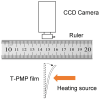Development of a Quartz-Based Photo-Mobile Polymer Film for Controlled Motion Triggered by Light or Heat
- PMID: 37109883
- PMCID: PMC10147076
- DOI: 10.3390/ma16083046
Development of a Quartz-Based Photo-Mobile Polymer Film for Controlled Motion Triggered by Light or Heat
Abstract
We have developed a photo-mobile polymer film, that combines organic and inorganic materials, to allow for controlled motion that can be triggered by light or heat. Our film is made using recycled quartz and consists of two layers: a multi-acrylate polymer layer and a layer containing oxidized 4-amino-phenol and N-Vinyl-1-Pyrrolidinone. The use of quartz in our film also gives it a high temperature resistance of at least 350 °C. When exposed to heat, the film moves in a direction that is independent of the heat source, due to its asymmetrical design. Once the heat source is removed, the film returns to its original position. ATR-FTIR measurements confirm this asymmetrical configuration. This technology may have potential applications in energy harvesting, due to the piezoelectric properties of quartz.
Keywords: contact-less actuator; energy harvesting; green energy; green polymers; photo-mobile polymer; sensors.
Conflict of interest statement
The authors declare no conflict of interest.
Figures







References
-
- Parameswarreddy G., Yadam Y.R., Arunachalam K., Sarathi R., Suematsu H. Investigation on the enhancement of electromagnetic shielding with efficient use of short carbon fiber in MWCNT-epoxy nanocomposites. Polym. Compos. 2023;44:1522–1533. doi: 10.1002/pc.27185. - DOI
-
- Castagna R., Lucchetta D.E., Rippa M., Xu J.H., Donato A.D. Near-frequency photons Y-splitter. Appl. Mater. Today. 2020;19:100636. doi: 10.1016/j.apmt.2020.100636. - DOI
-
- Li Y., Li Y., Huan D., Li L., Liu H., Wang W., Wang J., Zhu C., Zhao N. The effect of nanoparticle fillers on glass fiber/poly-ether-ether-ketone prepreg laser absorbance, thermal conductivity and interlayer performance. Polym. Compos. 2023;44:1836–1848. doi: 10.1002/pc.27208. - DOI
-
- Lucchetta D., Simoni F., Hernandez R., Mazzulla A., Cipparrone G. Lasing from chiral doped nematic liquid crystal droplets generated in a microfluidic device. Mol. Cryst. Liq. Cryst. 2017;649:11–19. doi: 10.1080/15421406.2017.1303898. - DOI
-
- Wang F., Zhang P., Luo J., Li B., Liu G., Zhan X. Effect of heat input on temperature characteristics and fusion behavior at bonding interface of CFRTP induction welded joint with carbon fiber susceptor. Polym. Compos. 2023;44:1586–1602. doi: 10.1002/pc.27190. - DOI
LinkOut - more resources
Full Text Sources
Miscellaneous

